Garmin’s Fenix 6 Pro Solar is one of the navigation brand’s most technologically advanced GPS smartwatches, boasting a claimed 16-day battery life thanks to its onboard solar charging display. That tech does come at a price, however, and the 47mm Pro Solar version of the Fenix 6 I tested costs a whopping £729.99.
Although Garmin recently launched the Fenix 7 to supersede the Fenix 6 as the brand’s range-topping device, the Fenix 6 Pro Solar is still on sale, but now offered with a chunky discount (£729.99 down to £549.99) at the time this review was published.
It has wrist-based heart rate monitoring and a pulse Ox2 meter, plus it can measure your respiration rate. There’s onboard mapping for cycling, mountain biking, golf and skiing.
There's also a host of familiar features, including phone notifications, Garmin Pay and the Garmin Connect IQ Store that lets you install third-party cycling apps such as Trailforks.
Rounding out the key features are custom watch faces and space for up to 2,000 songs stored locally on the watch thanks to 32GB of storage.
Clearly, the Fenix 6 Pro Solar GPS smartwatch is for the fitness and sporting enthusiast, but how does it perform for cyclists and mountain bikers? Can it solve the problem of needing a dedicated GPS bike computer thanks to its rich feature set?
Garmin Fenix 6 Pro Solar Edition GPS smartwatch specifications
Size, form and sensors
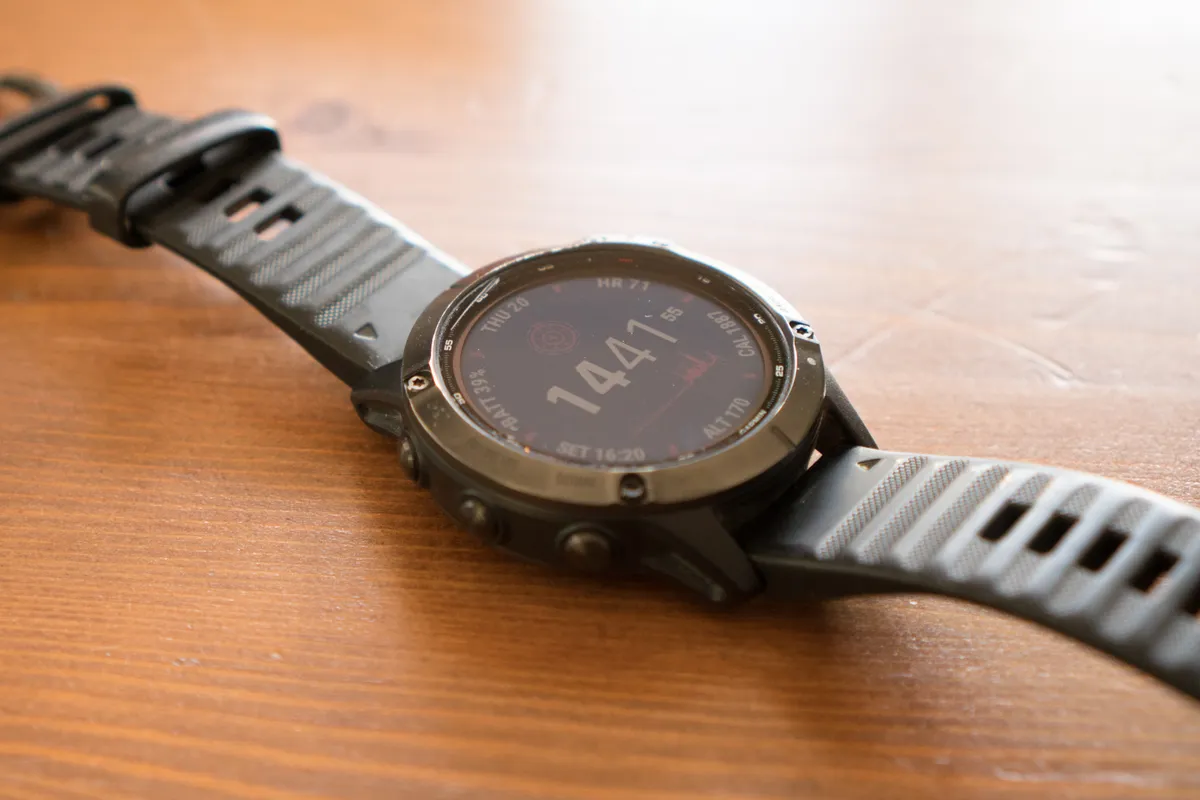
This version of the Fenix 6 has a stainless steel 47mm-diameter case, with a 33mm-diameter screen embedded within. It’s 15.1mm deep and weighs 83g with the standard silicone strap, designed to fit wrist circumferences between 125mm and 208mm.
The screen uses a 260x260 pixel resolution and has a sunlight-visible transflective colour display, meaning it's easily viewed without the backlight in direct sunlight.
It has a 10 ATM water rating, so can withstand water pressures equivalent to a depth of 100 metres.
GPS, GLONASS and Galileo satellite tracking take care of logging your whereabouts, while there's also a built-in barometric altimeter, compass, gyroscope, accelerometer and thermometer.
Connectivity-wise, Bluetooth and ANT both feature, so it's easy to link the watch to heart rate straps, power meters, and speed and cadence sensors.
You can also connect the watch to WiFi networks for on-device activity uploading.
Solar charging and battery life
This model of the Fenix 6 has a solar charging lens, so battery life is claimed to last up to 16 days in smartwatch mode, and up to 40 hours in standard GPS mode.
This can be increased to 93 hours if one of the watch’s battery-saving modes is engaged and used with solar charging.
Sport types
The Fenix 6 Pro Solar is pre-loaded with plenty of activity types, from cycling, walking and running, through to gym-based activities with animated instructions, and other sports such as skiing, kayaking and golf.
Each sport profile has customised data screens that can be further modified to suit your needs.
In-built sensors and fitness tracking

Thanks to the in-built, wrist-based heart rate and pulse Ox2 monitors, the watch can provide a wide range of data without the need for additional external sensors.
It continuously monitors heart rate and pulse Ox2 (how oxygenated your blood is), providing information on your "Body Battery" (which indicates how much energy you have and how active you should be), recovery time (telling you how long you need to rest after an activity), workout suggestions (how hard to train and when), performance metrics (V02 max estimation – more on this later – and heat and altitude acclimatisation), sleep monitoring and respiration rate tracking.
Mapping and apps
With detailed maps pre-loaded for cycling, walking and running, along with skiing, there are few instances where additional downloads are required.
However, should your activity location or sport type not have a suitable map pre-loaded on the device, Garmin’s website provides free downloads from a vast library of additional maps. The maps are compatible with turn-by-turn navigation and are well detailed.
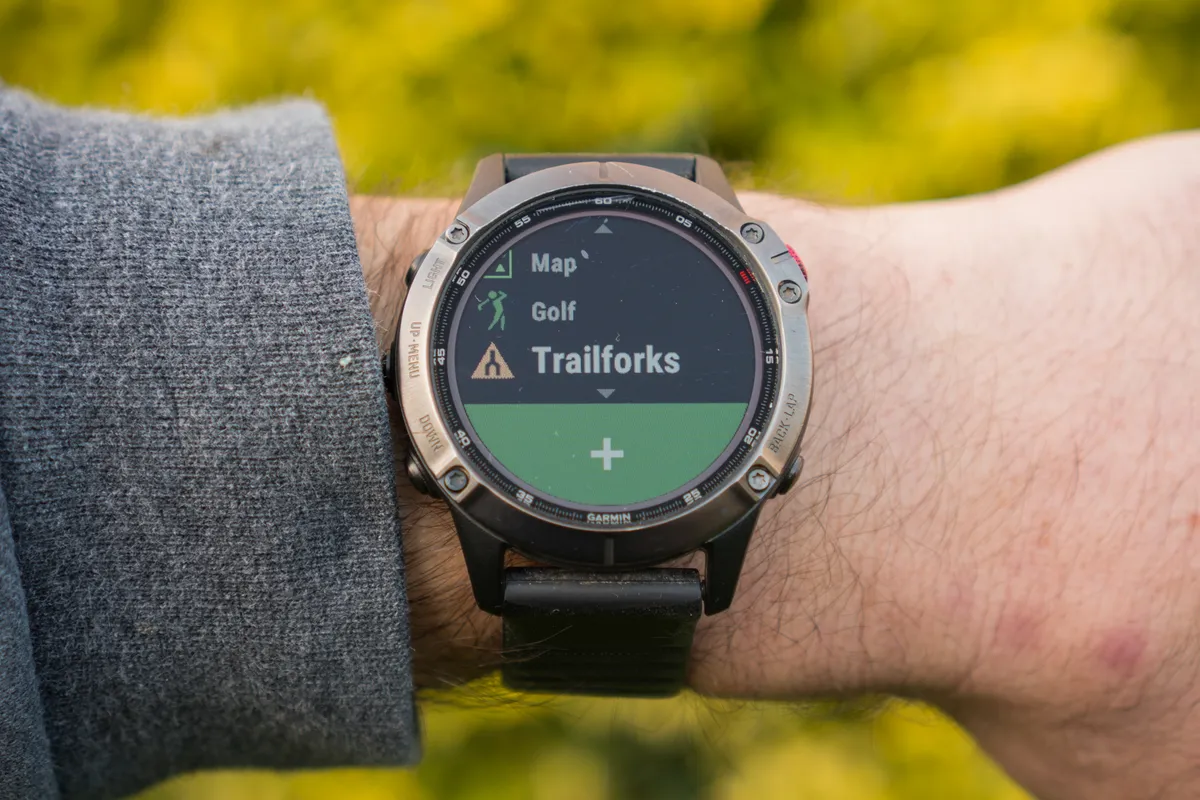
It’s possible to enhance the device’s mapping and routing capabilities further with downloads from the Garmin Connect IQ Store. Downloaded apps are loaded onto the watch and, while some of them run offline on your wrist, others require a smartphone connection.
Other apps, such as Spotify and Komoot, plus customisable watch faces, are also available for free download.
Garmin Connect app connectivity
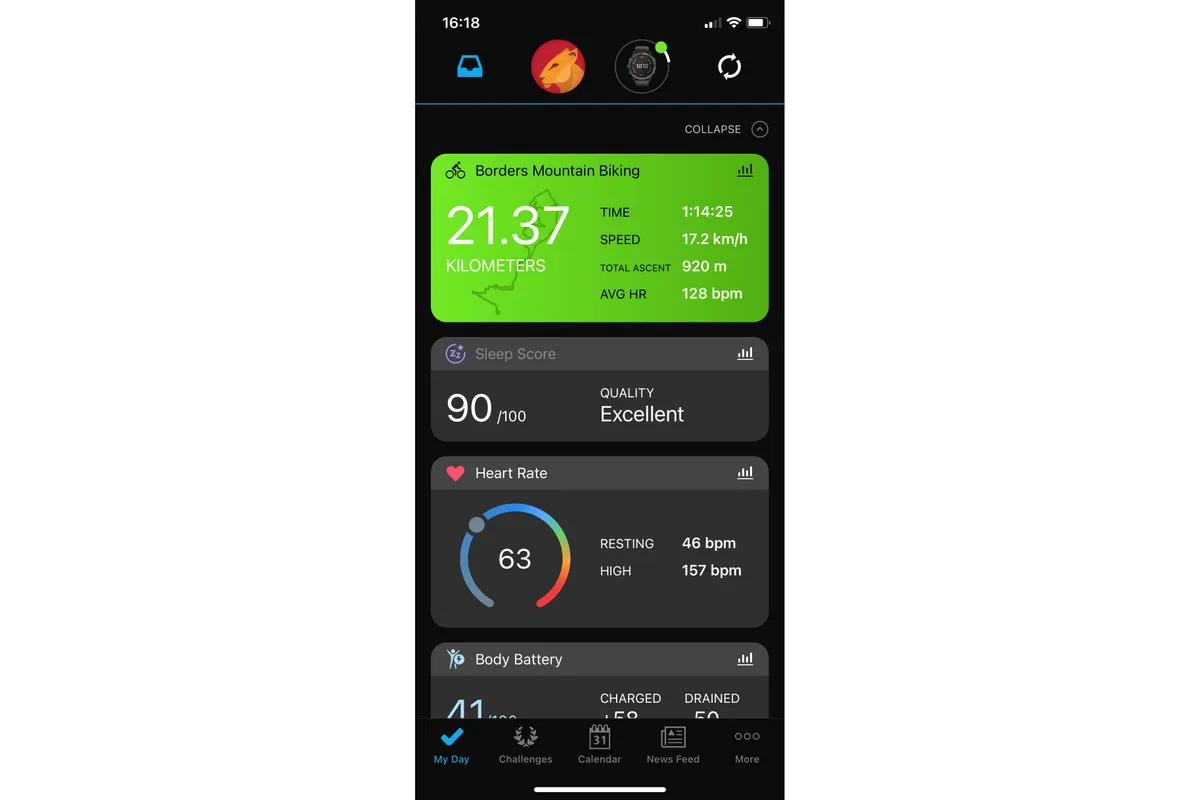
Although it’s possible to use and set up the Fenix 6 Pro Solar without a smartphone, more features and detailed training information are better accessed through the Garmin app.
The Connect app acts as a bridge between multiple devices (if you own them) and collates all your fitness and activity data into one area. If you don’t have a smartphone, it’s also possible to connect and sync the watch via USB on a compatible computer using Garmin’s Express app.
Garmin Fenix 6 Pro Solar GPS smartwatch performance
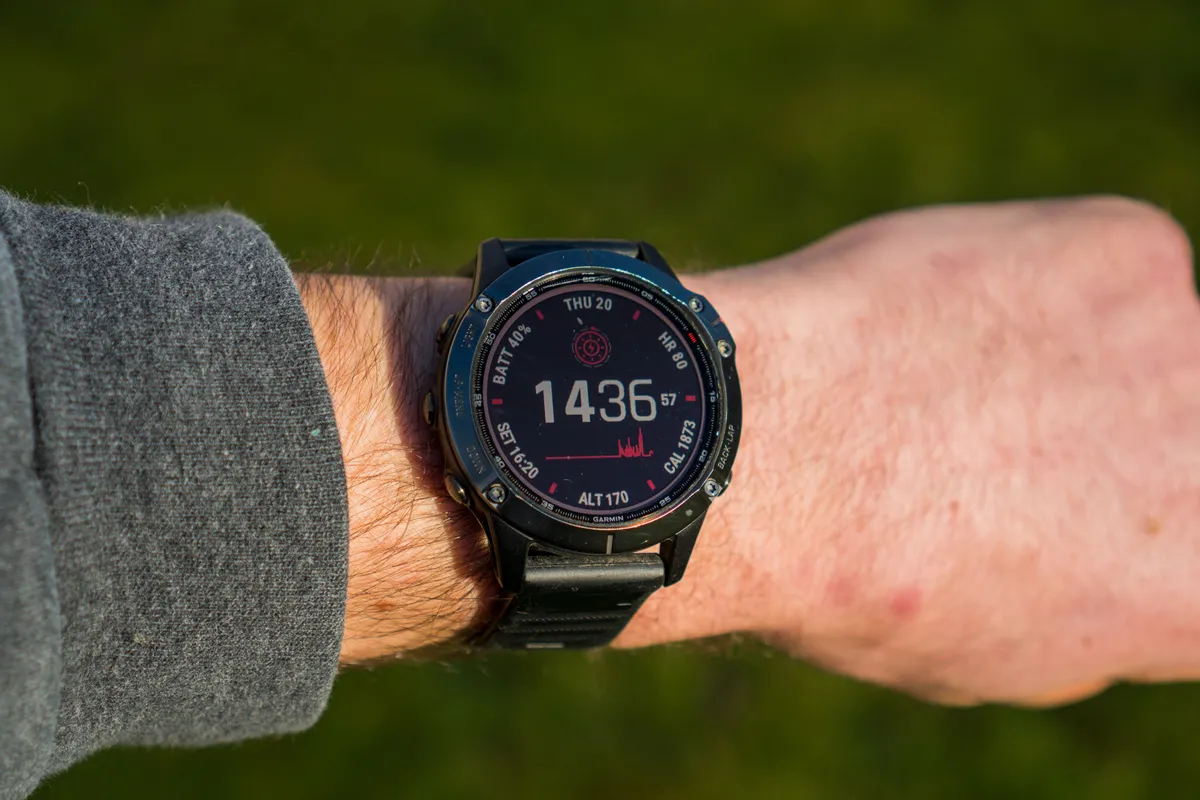
I tested the Fenix 6 Pro Solar over the course of nine months through late spring and summer, and into deep winter. I’ve used it for kayaking, running, walking, mountain biking, ebiking and road riding to get a true sense of how the watch performs.
I’ve worn it constantly day and night (except for charging) over that time period, and have used it alongside a Garmin Edge 830 bike computer.
My experiences below are written in the context of mountain biking and road riding, rather than any of the many other activities the watch is designed for. Most of my testing was done off-road on mountain bikes, however.
Comfort and wearing

The Fenix 6 Pro Solar feels light on the wrist and isn’t as bulky as its dimensions suggest.
It fits comfortably under long sleeves without creating a bulge, but is large enough to hold back cuffs if they’ve been pulled above the watch.
This is useful on cold days when you want your sleeves down, and warmer ones when you want them to remain up. Holding the sleeve up also helps get the maximum amount of sunlight into the watch to charge it.
I found it impressively comfortable to wear on the bike, but only once I’d experimented with how tight the strap was.
Too tight and the watch body would tap against my Ulna bone’s bulge, making it sore, while running it too loose caused the watch to slip down, hurting the back of my hand, especially when riding over particularly rough terrain.
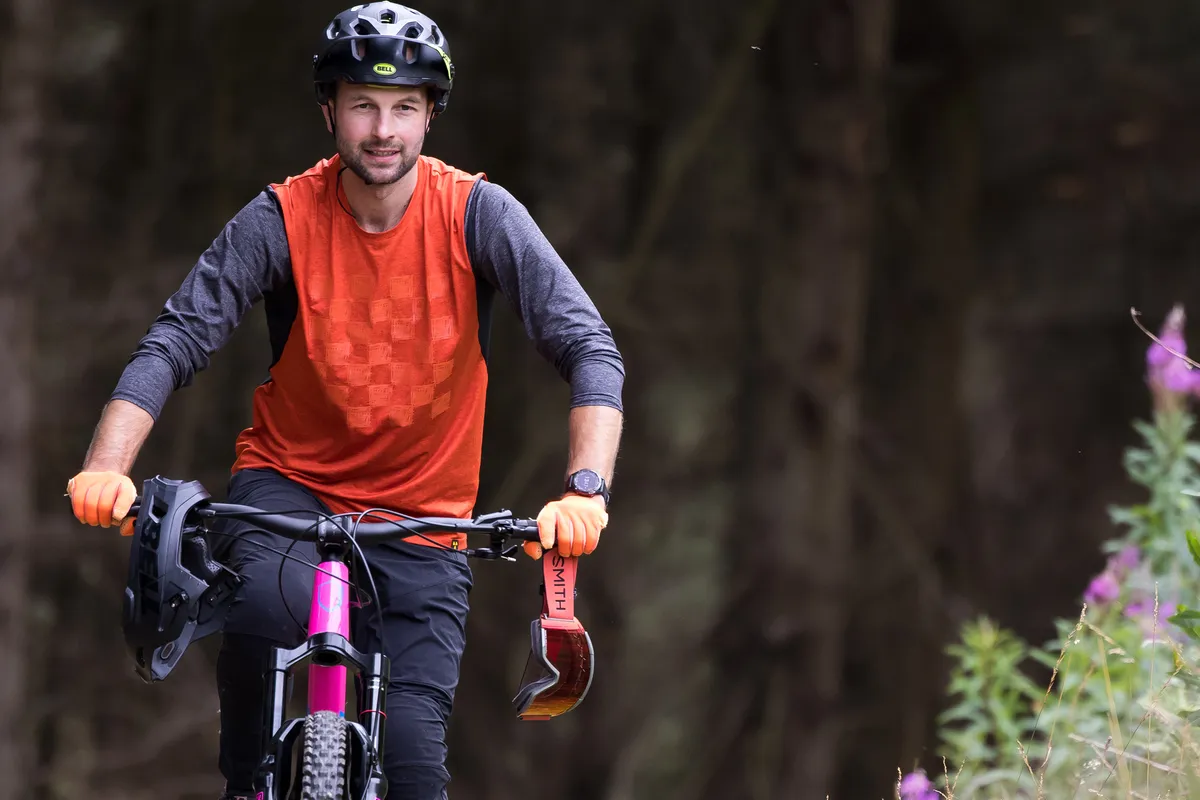
Once I’d found the perfect tightness, the silicone strap didn’t cause any irritation on my skin, even when the watch was worn 24/7.
If you have a history of easily irritated skin, a metal band is also available, but I would recommend regularly cleaning the watch and strap, and removing it for periods to let your skin breathe.
Robustness
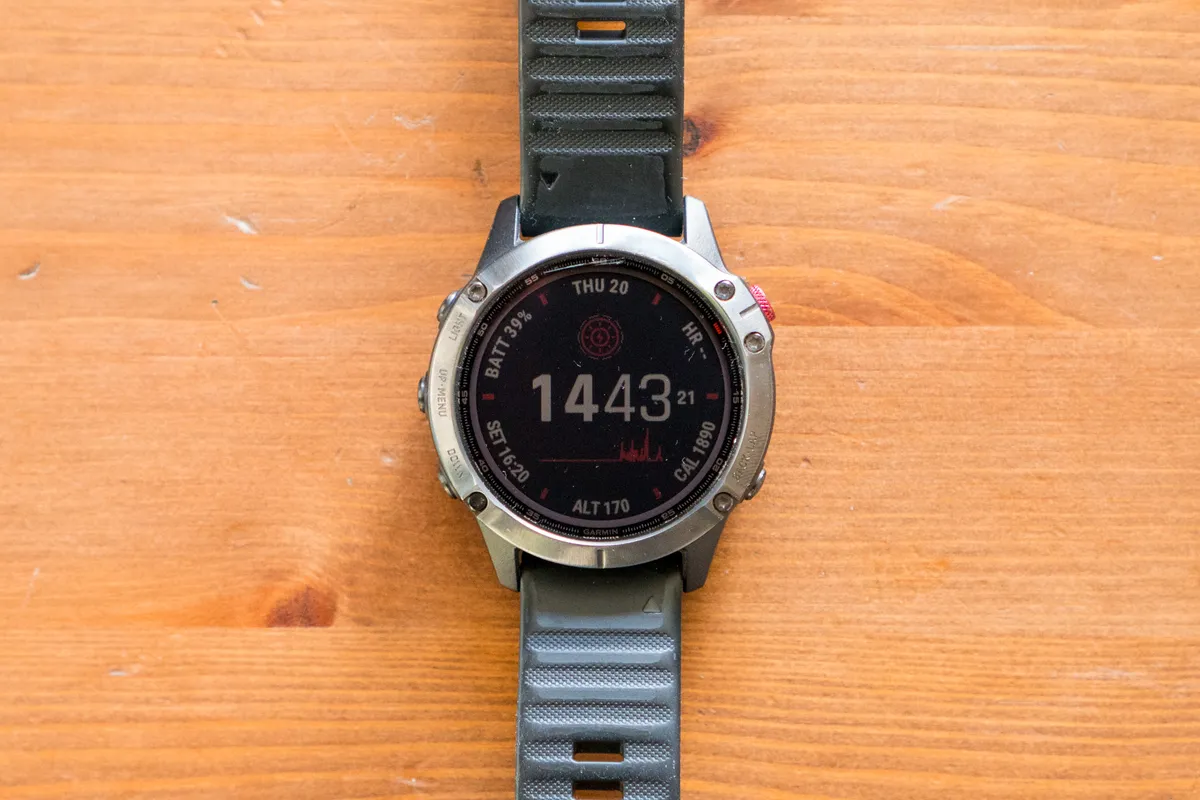
Crashing is one of the accepted risks of being a cyclist. Unfortunately, in the summer of 2021 I had a particularly nasty smash resulting in a written-off helmet and a few weeks off the bike. Luckily (solely in the context of this review), I was wearing the watch when I crashed, so I was able to test how strong it was.
The watch’s bezel and face contacted the ground, leaving scuff marks on the stainless-steel body, and a small unremovable scratch on the exterior edge of the glass.
Impressively, given the scale of the impact, the glass didn’t crack or become damaged. None of the buttons broke, and neither did the watch’s solar charging feature. Equally, its waterproofing wasn’t compromised by the impact.
In my experience, the Fenix 6 Pro Solar is an incredibly robust unit and can rough and tumble with the most active people, despite its rather Gucci price tag.
Ease of use
Its five-button user interface, rather than touchscreen system, while not initially intuitive, is quick and slick to use once each of its button’s functions have been mastered.
The side-mounted buttons are large enough to use while wearing bulky winter cycling gloves – and have a firm but definitive push that leaves no doubt about whether they’ve been pressed.
Long pushes of the buttons double up on functionality, helping to switch directly to certain menus or apps without needing to cycle through menus.
Although we’ve become accustomed to touchscreens as the go-to and most intuitive user interfaces, the Fenix 6’s physical controls are well suited to its application and smaller (than a smartphone) screen size.
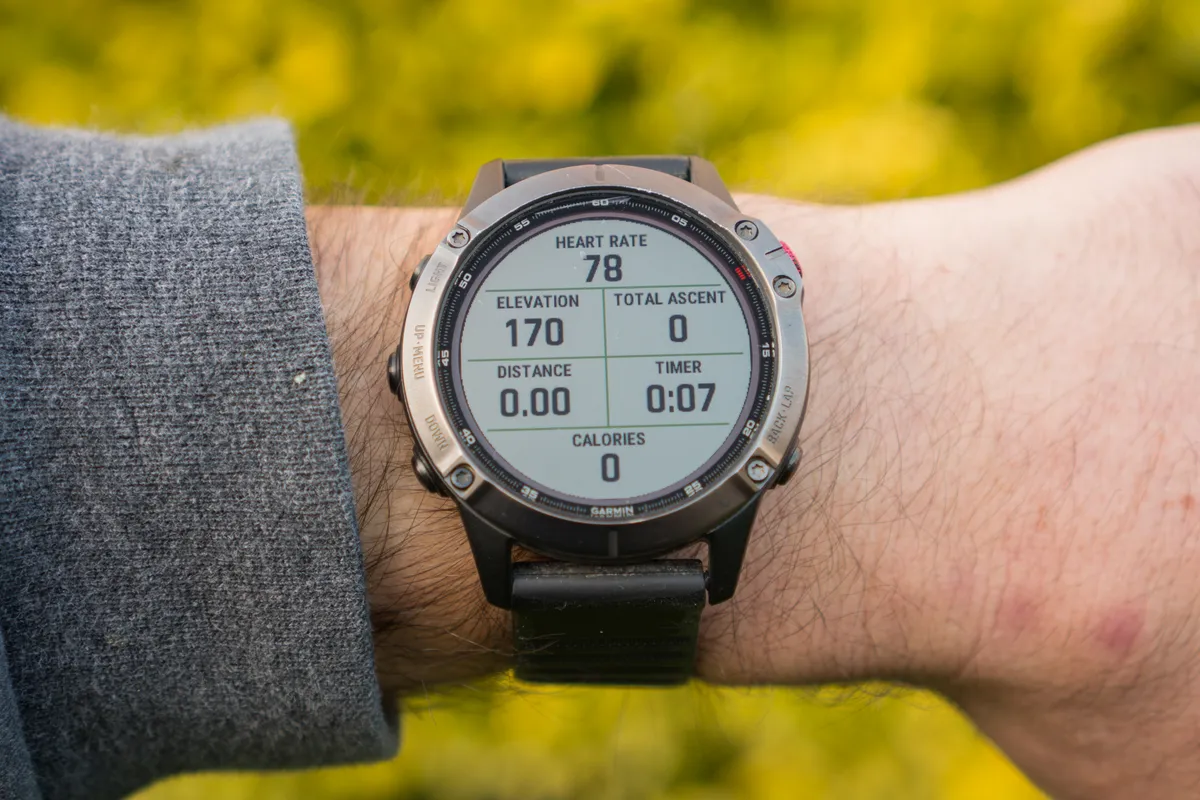
The screen’s backlight isn’t needed to see the screen in dawn-to-dusk light, no matter the weather. Its brightness is adjustable, but I found the minimum setting more than adequate, and setting it low saved battery life.
Battery life and solar charging
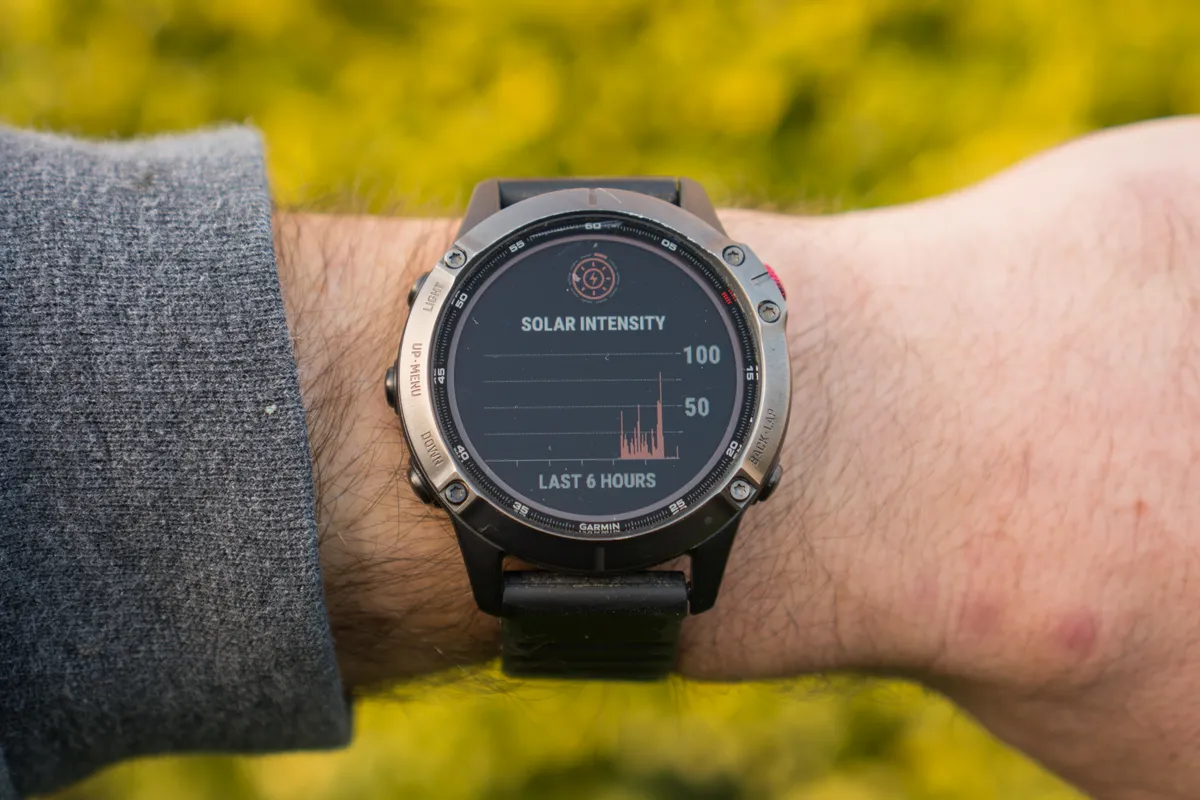
True to Garmin’s claims, when used as a smartwatch with constant heart rate monitoring and nighttime-only pulse Ox2 tracking, the Fenix 6 Pro Solar would last on average 14 days between charges.
Battery depletion would be between five and eight per cent in any 24-hour period, with the majority of that happening at night when the pulse Ox2 tracker was enabled.
In my experience of using the watch in Scotland, the solar-charging function couldn’t charge the watch’s battery. Instead, it slowed down the speed at which the battery drained to between three and seven per cent in any 24-hour period, even when worn without actively trying to increase its battery life. The longest time I went between charges was 16 days, once again true to Garmin’s claims.
People living in sunnier climates might experience longer times between charges, however.
When used as the primary GPS activity tracker, the battery would last around seven days. A two-hour activity usually drained between three and 10 per cent of the battery’s charge, whether it was connected to an external heart rate monitor or not.
This makes the Fenix 6 Pro Solar’s scope truly mighty, and only the most dogmatic exercisers will need to charge it twice a week.
Its battery life is massively commendable and extends the Fenix’s usability into the realms of consolidating smartwatch and dedicated cycle computer into one.
Fitness, heart rate and Pulse Ox2 tracking
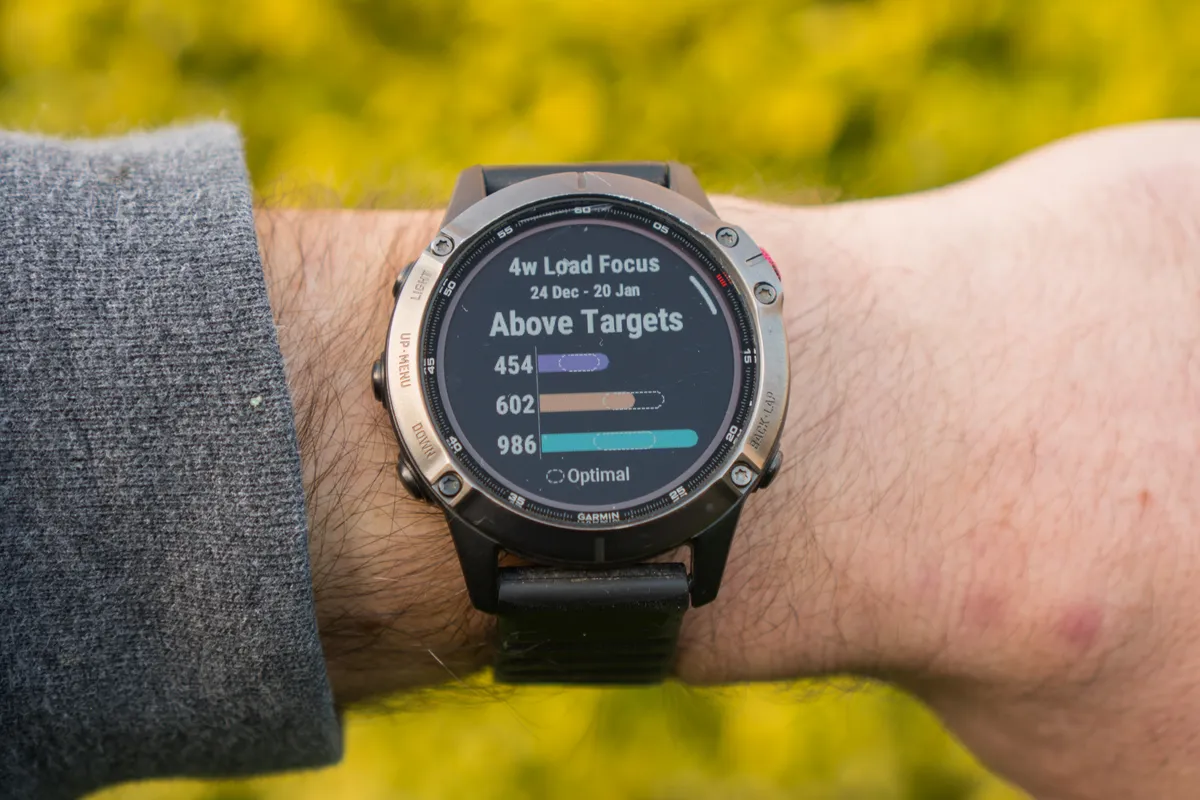
All of the watch and smartphone app’s algorithm-based fitness monitoring – such as recovery time, Body Battery, sleep monitoring and performance metrics – is only as good as the sensor data it receives.
Each of the fitness monitor features 'talks' to the others to help you build a clear picture of how you’re training and what type of condition or state your body is in. When they’re getting reliable data, they’re brilliant tools to use for the average fitness fanatic.
Each of the features provides genuine insight that is interesting, and at times, enlightening and directive, permitting you to tailor your riding to suit your body’s current needs.
As mentioned, though, the information each metric provides is only as good as the sensor data it has access to.

The wrist-based heart rate monitor’s reliability when used on a bike is variable. Factors such as strap tightness, skin colour, arm hair, blood flow through the wrist and vibrations all influence how accurate its readings are.
I struggled to get the wrist-based monitor to tally with the readings given by a chest-based heart rate monitor and stopped using the watch’s in-built sensor if I wanted to reliably track activities. Garmin has an extensive support document detailing what can affect heart rate monitor accuracy.
This problem isn’t exclusive to Garmin, however, and looks tricky to solve. If you’re after the most accurate readings, I recommend investing in a chest-based heart rate monitor.
As a cyclist, to use the watch’s Training Status feature you need access to a compatible power meter and heart rate monitor (the watch’s wrist-based monitor is fine) to get a status. Without one, Garmin’s algorithms aren’t able to perform the necessary calculations.
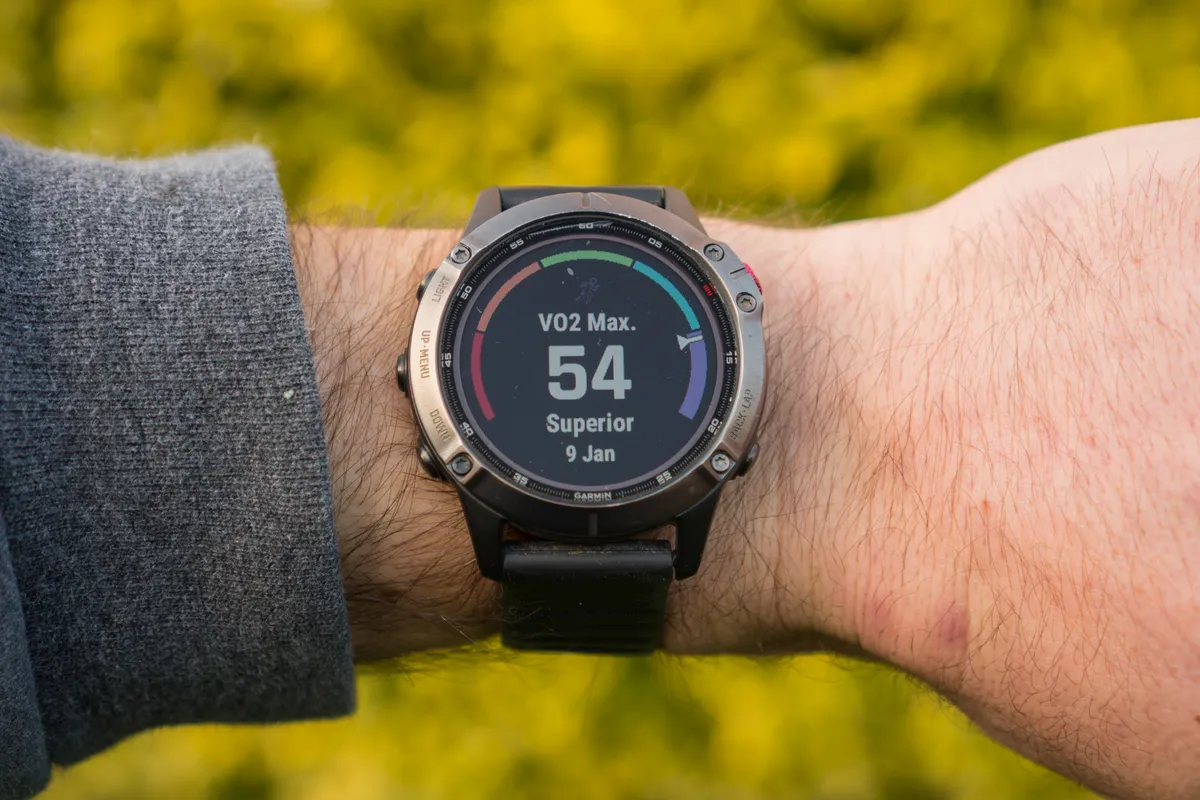
It is possible to get a Training Status by running, but data from bike rides without a power meter will not contribute directly to a Training Status generated by running. If you want to sustain Training Status data for cycling, you need to continue to cycle with heart rate and power data.
Although the different activity types do contribute to the training load, recovery time and estimated VO2 max data displayed on the watch, cross-sport training will not directly affect your Training Status for other sports. However, it can detect when you are not training within what the watch determines are the optimum parameters, such as if you’re not performing as expected on the bike because your legs are tired from running.
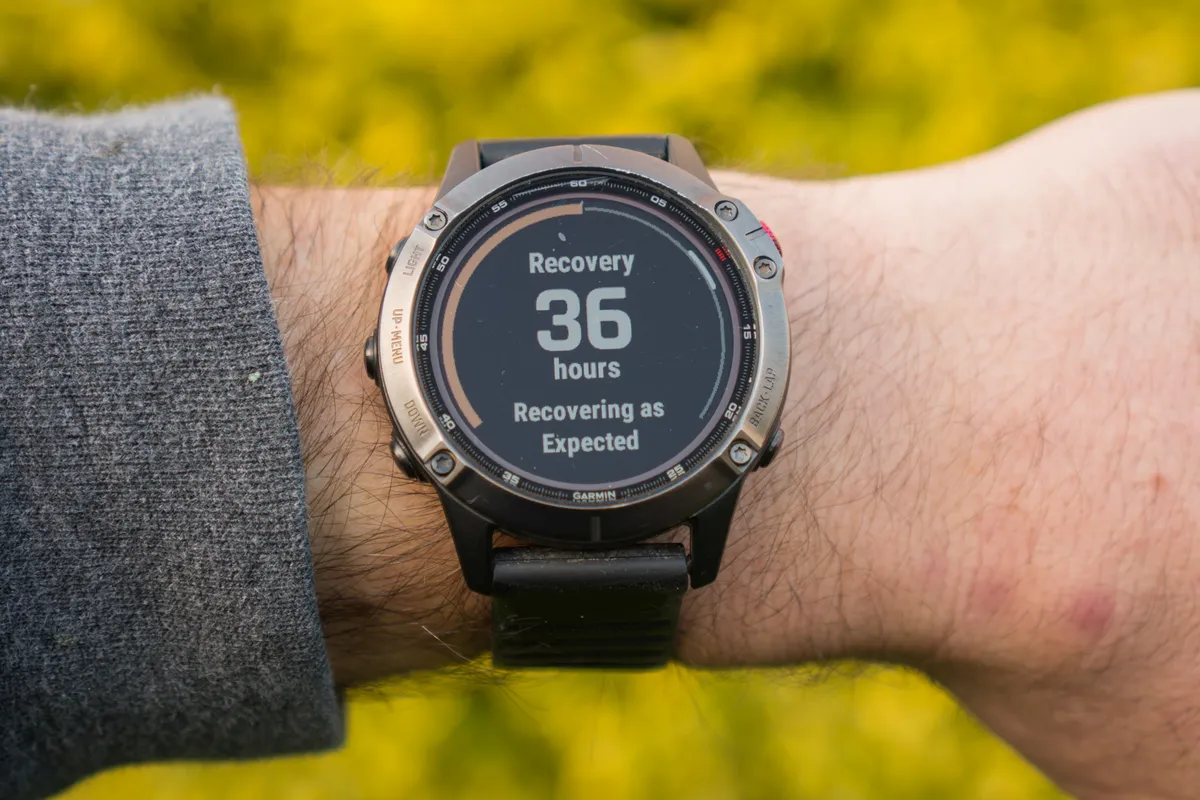
Garmin’s Training Status algorithm is incredibly complex and is always under development, but clearly has some limitations in terms of the data it requires to make its calculations.
For cyclists, to get access to the maximum amount of information the Garmin ecosystem can provide, I recommend you purchase a power meter to supplement your heart rate data.
GPS, altimeter, compass and temperature sensor accuracy

GPS tracking accuracy is as good as a dedicated device, or any other GPS devices I’ve recently used. Depending on how far I’ve travelled since last using the GPS, it can take between 20 seconds and two minutes to get a signal.
The inbuilt barometric altimeter – if left to its own devices without frequent GPS or app-based calibration – is less accurate.
I found that after two to three days of not using the watch’s GPS or altitude-calibration function, the altitude reading increases or decreases, without a limit to the changes. Once it has become uncalibrated like this, it is also slow to measure changes in altitude.
For the most accurate readings, I found calibrating it every few days was essential.
From a functionality perspective (in terms of all the watch’s other features) a wandering altitude reading isn’t problematic, and a calibration soon puts it right.
The compass proved to be as accurate as an old-fashioned (yeah, I said it) analogue version, but senses the direction the watch is pointing when it’s perpendicular to the direction of travel, so care needs to be taken to get an accurate reading.
Temperature sensor readings were heavily influenced by my body’s heat. Even with the watch face exposed to the air, residual heat from my arm swayed the reading. This was a shame, but an inevitable issue with a wearable.
Mapping and navigation

The onboard mapping is impressive. They are clear to read on the watch’s screen, and details such as footpaths, bridleways, forest tracks, even buildings and bodies of water, are clear to discern.
Scrolling and zooming the map is performed using two of the five buttons and is relatively quick to do, although tricky while you’re on the move. It’s not as intuitive or quick as the touchscreen map on the Edge 830, but is no less difficult to operate than Garmin’s Edge 530 map-scrolling system.
I couldn’t integrate the onboard Trailforks app map into the normal activity-based map, which meant that specific trails, their names and locations aren’t visible within the ride recording pages.
That’s a minor disappointment at worst, and hopefully Garmin is working on a way to integrate the two maps.
The Fenix's route navigation functionality and user interface are almost identical to the Edge 830.
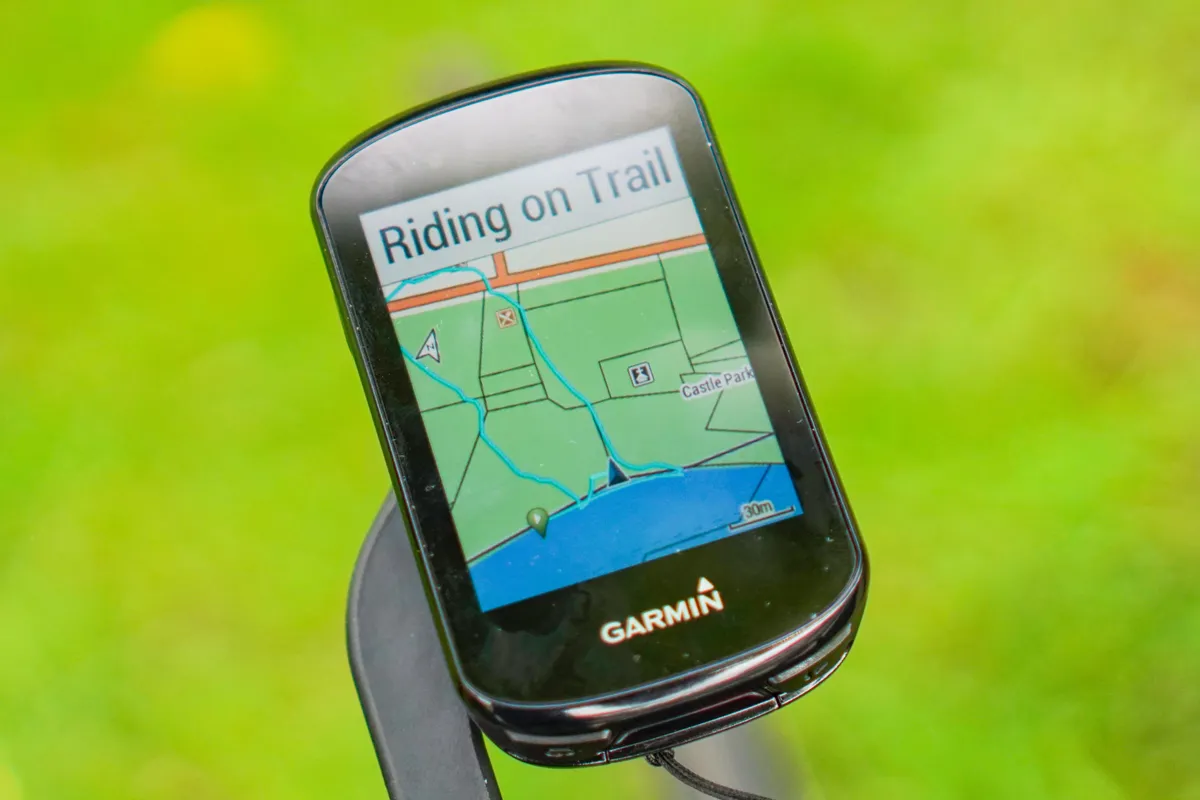
Turn-by-turn directions are clear and easy to see and follow, with large bold arrows indicating which way to turn and when. As you approach a turning, the map’s screen is switched from the map to a high-contrast, large-scale instruction with distance remaining.
It features re-routing (like the Edge 830), and can navigate you to the start of your route. From a functional perspective, the Fenix 6 works as well as Garmin’s dedicated GPS units.
While the size of the screen does pose its limitations – you’re always going to have to sacrifice detail if you want to see more of the route, or the finer details depending on how zoomed in you are – Garmin has done a commendable job of integrating its brilliant mapping and navigation software into the Fenix.
Looking at your wrist to check the way you’re riding is the same as the route you’d planned is no less invasive than looking at a bar-mounted GPS, as long as your sleeve is positioned in a way that means the watch is permanently visible. However, its smaller size means focusing on the details takes a little more time, and could be off-putting to some.
When navigating, the size of the device poses some compromises compared to dedicated GPS units, but Garmin’s workarounds prove to be good at mitigating any issues.
Could you rely on the Fenix 6 Pro Solar to navigate you into virgin backcountry territory? Yes, you could. Is it as good as the Edge 830 at doing so? Arguably not, but it isn't far off.
Apps and accessories
Apps are quick and easy to load onto the watch via a smartphone and the Garmin Connect IQ Store app. All transfers take place over Bluetooth and the watch is still functional during the download process.
Thanks to its Bluetooth, ANT and WiFi connectivity, it is compatible with a host of other accessories. Check out the Garmin website for a full list.
Suitability for cycling and mountain biking
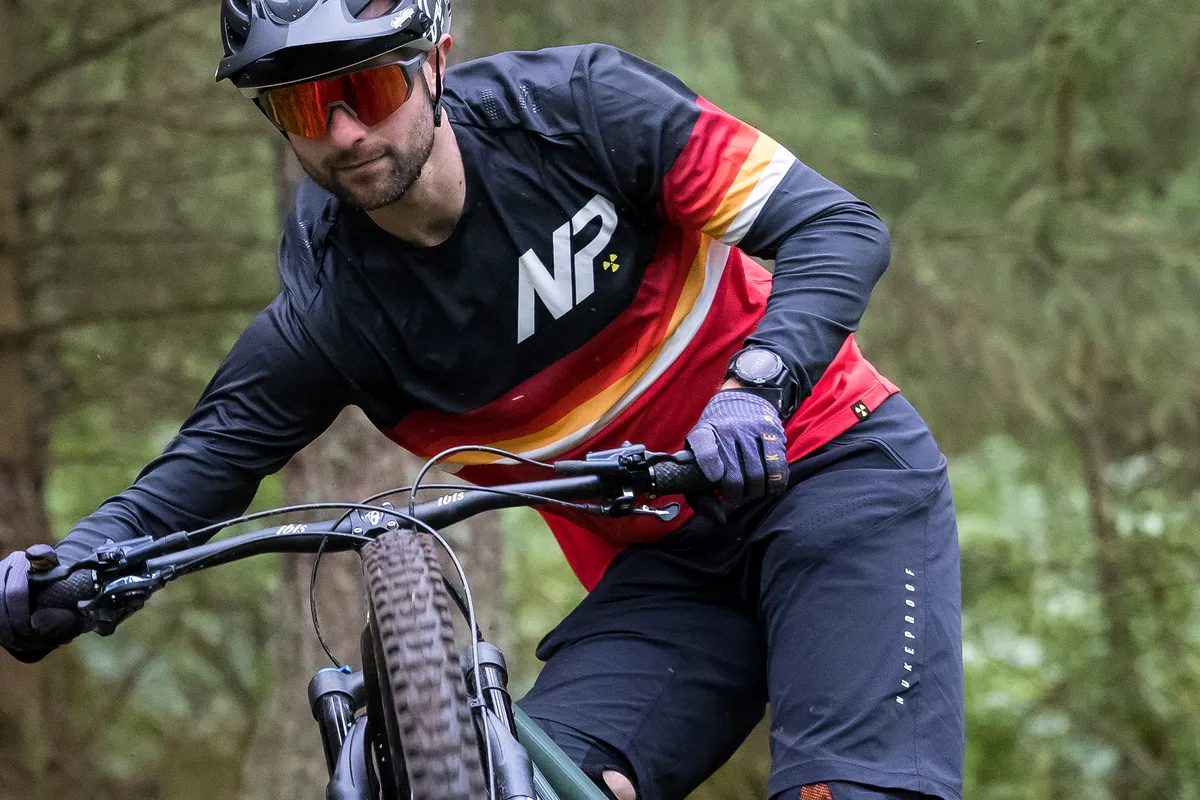
Thanks to its robust, easily wearable design, and massively rich list of features, there’s very little the Fenix 6 Pro Solar can’t do that a dedicated bike computer can.
It’s relatively easy to operate on the move and the screen’s size, colour and contrast mean that at-a-glance data is easy to see and absorb. And if you find it uncomfortable to wear while cycling, Garmin sells a dedicated bike mount, so it can be mounted to your bars.
Garmin Fenix 6 Pro Solar GPS smartwatch bottom line
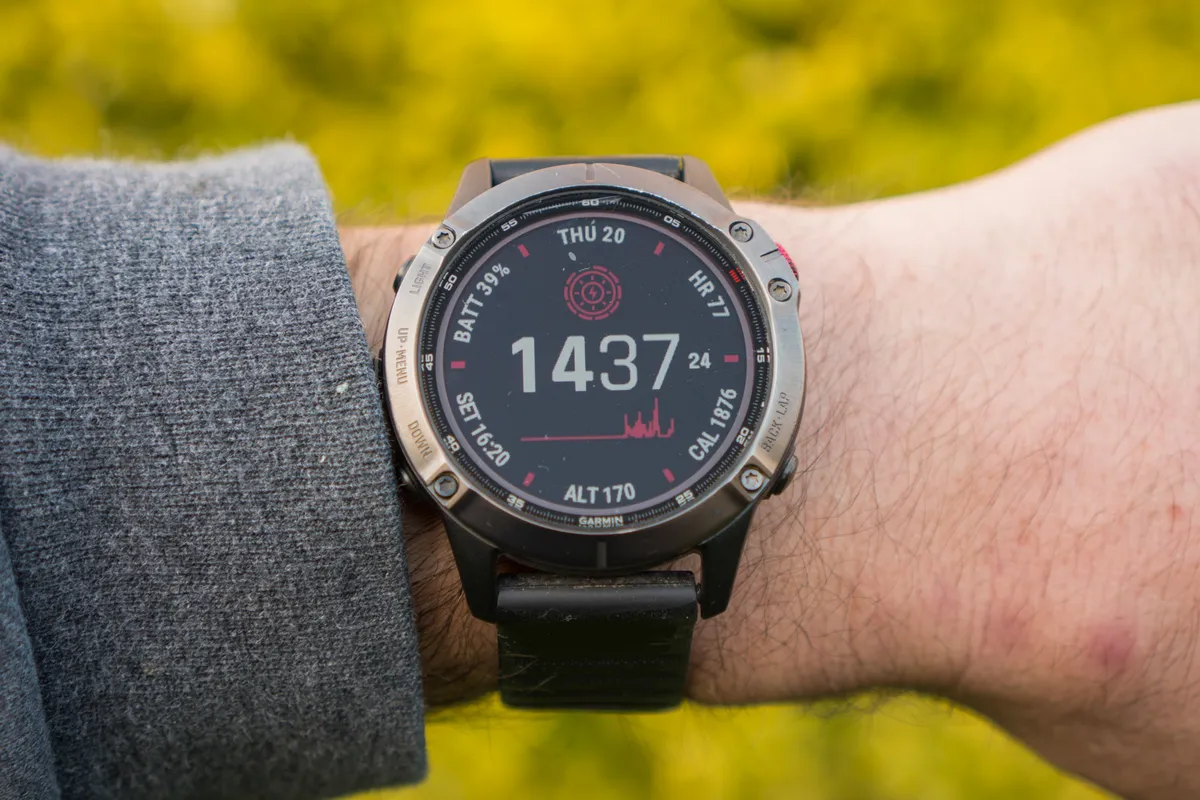
With the Fenix 6 Pro Solar, Garmin has done a fantastic job of cannibalising the usefulness of the Edge 830 bike computer. I now use the Fenix 6 on nine out of 10 rides, only opting for the Edge 830 if I need quick access to Trailforks or accurate temperature readings.
For me, the beauty of the watch lies in its simplifying of data collection. A dedicated bar mount isn’t necessary, it doesn’t need to be turned on, and most of the essential sensors are included in its body. This speeds up the process of getting out on the bike and going riding, while all of the post-ride geeking out can still happen without the need to think about taking a dedicated device.
It’s not without its faults – some of the problems are shared by all wearables regardless of brand, others thanks to how Garmin calculates your fitness data and the metrics it needs to do this – but both are circumvented with additional accessories the most serious fitness fanatics will either own or be researching in preparation for an additional purchase.
Yes, it’s expensive, but so is purchasing an Edge 830 and a dedicated smartwatch, and the Fenix 6 Pro Solar removes the need for a secondary device.
With a slick user interface, monumental battery life, loads of interesting and useful data, plus 99 per cent of the functionality of a bike computer, there’s little reason to not consider a Fenix 6 Pro Solar.
If you’re in the market for a fitness tracker and a bike computer, or want to consolidate multiple devices into one, this watch should be at the top of your list.
Product
| Brand | garmin |
| Price | 1499.00 AUD,799.99 EUR,729.99 GBP,799.99 USD |
| br_whatWeTested | Garmin Fenix 6 Pro Solar Edition, 47mm, silicone band, slate grey |
| Weight | 86.0000, GRAM (47mm) - Stainless steel case, 22mm silicone band |
Features
| br_rechargeableBattery | yes |
| br_turnByTurnNavigation | yes |
| br_screenType | Fenix_6_Pro_Solar_Screen |
| br_connectivity | antPlus |
| br_connectivity | bluetooth |
| br_connectivity | wifi |
| br_maps | Golf, topographical, road and trail, ski resort, Garmin cycle map, |
| br_dimensions | 47mm diameter, 15mm deep |
| br_batteryLife | Up to 16 days smartwatch, up to 40 hours GPS |
| br_waterResistance | 10ATM |
| br_screenDimensions | 33.02mm |
| br_displayResolution | 260x260 pixels |
| br_sensorCompatibility | Speed and cadence, power meter, heart rate |
| br_HeartRateMonitorType | Wrist-based |
| br_ReplaceableStrap | 1 |
